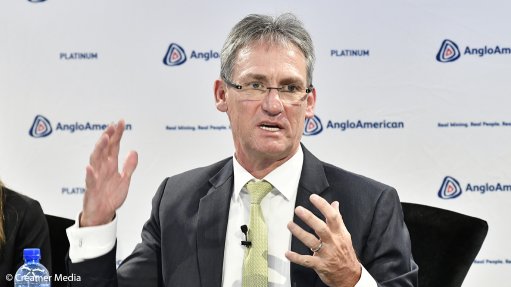
Chris Griffith
Photo by: Creamer Media's Donna Slater
The introduction of hydrogen fuel cell mining in response to climate change is poised to cut the greenhouse-gas (GHG) emissions of platinum group metals (PGMs) mining company Anglo American Platinum (Amplats) by 30%.
A large enabler of this significant reduction was the introduction of hydrogen fuel cell mining trucks, outgoing CEO Chris Griffith said this month at the company’s presentation of superlative 2019 results.
“These trucks will use green hydrogen generated from solar photovoltaic farms and will have zero carbon emissions. We’re on track to trial the first hydrogen fuel cell truck at Mogalakwena in the second half of this year,” Griffith said during the presentation, attended by Engineering News & Mining Weekly.
Amplats generated operating free cash flow of R16.9-billion, further strengthening the balance sheet to a best-ever net cash position of R17.3-billion. The 2019 dividend payout totalled R14.2-billion, the highest since 2006.
“In response to the global challenge of climate change, we continue to find improvements in both our energy use intensities and our emission reductions.
“We’ve reduced our energy intensity by 10% since 2016. We’ve reduced our GHG emissions by 7% over the same period and we’ve now set ourselves 2030 targets to improve energy efficiencies and to reduce absolute GHG emissions by 30%, off a 2016 baseline,” Griffith said.
Amplats is continuing to receive global recognition in many areas of environmental, socioeconomic and governance (ESG). There were no fatalities in the 12 months to December 31 and the tuberculosis incidence rate was halved. Since 2016, waste to landfill volumes have been cut by 83% and potable water use has been reduced by 9% as part of the company’s vigorous ESG drive.
Operationally, overall PGMs production was up 1% year-on-year to 4.4-million ounces, but with electricity load-shedding by Eskom leading to the loss of 38 000 oz of production.
Once again, Amplats had record 5%-higher production at its Unki platinum mine in Zimbabwe and record 4%-higher production at its Mogalakwena platinum mine, in Limpopo, South Africa.
Unki, which produced 202 000 PGM ounces, generated free cash flow of R1.1-billion at an all-in sustaining cost (AISC) of $88/oz of platinum sold.
Obstacles that had to be removed to achieve the record performance at Mogalakwena were a cracked mill and a rope shovel rebuild.
Strong processing in particularly the second half of 2019 resulted in 11% more refined ounces being produced, despite Eskom power outages that led to an 89 000 oz disruption that will now be processed this year.
AISCs were slashed to a magnificent $293/oz of platinum, compared with the realised platinum sales price of $861/oz.
Mogalakwena’s earnings margin was 56% and it returned 55% of the capital employed in the mine.
Production of 1 215 000 oz of PGMs generated R9.9-billion of economic free cash flow and a negative AISC of $429/oz of platinum sold, highlighting the benefit of the basket of metals mined. In August, the mining right area on the northern limb of the Bushveld Complex was doubled by acquiring the Kwanda North and Centre Block prospecting rights.
The two additional chrome modules commissioned at the rhodium-rich Amandelbult platinum mine will result in an incremental 340 000 t produced a year. This mine, which produced 893 000 oz of PGMs, generated R3.3-billion in free cash flow at an AISC of $390/oz of platinum sold.